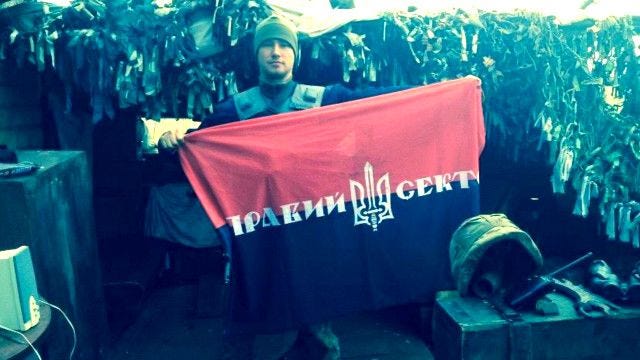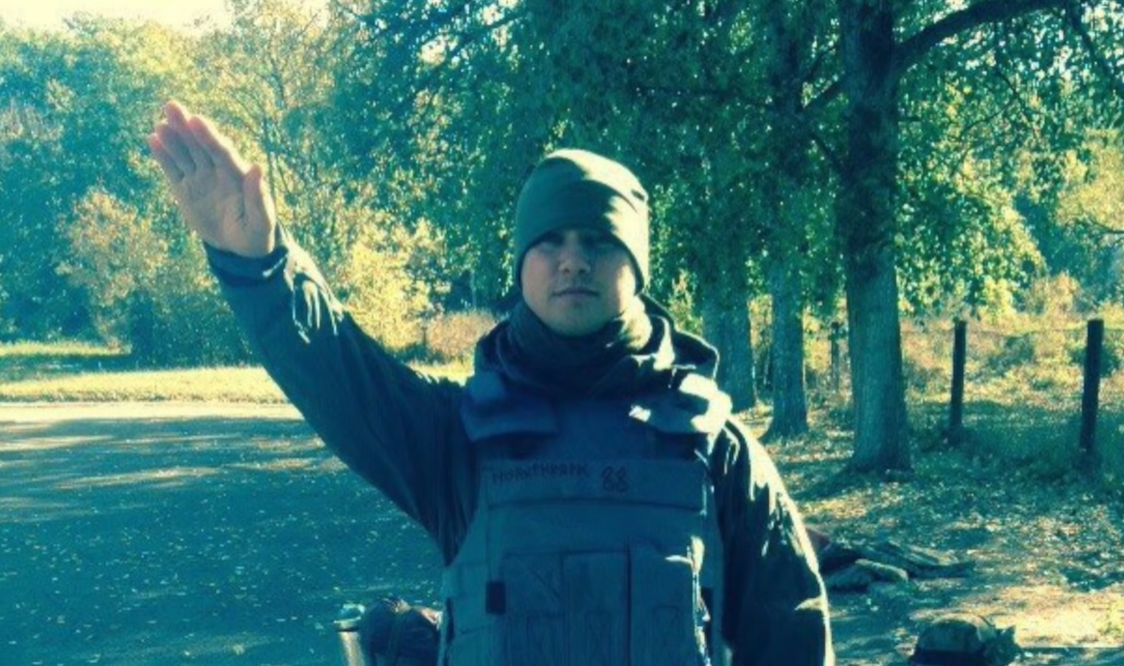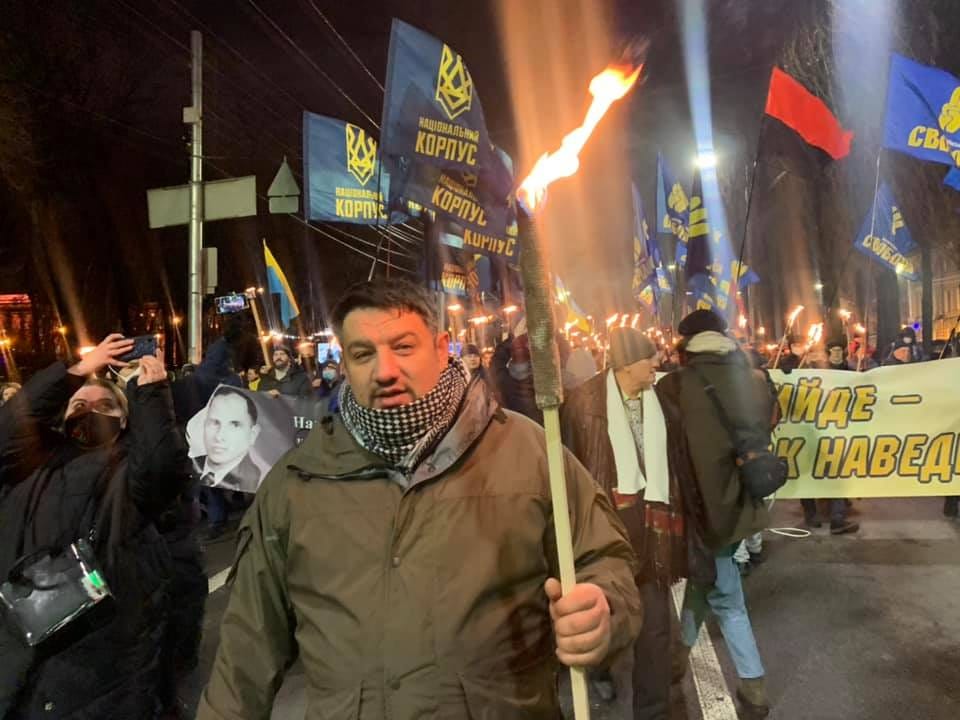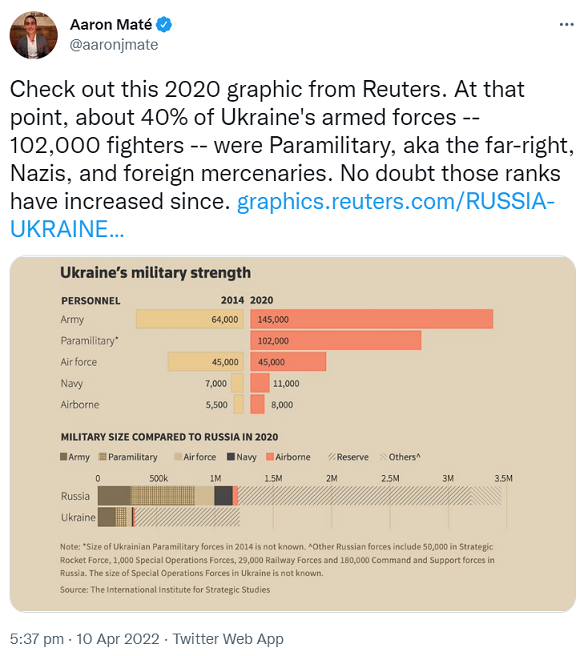Media coverage of fascism in Ukraine: Who’s to blame for ‘disinformation’?
For all its dodgy Cold War origins, Radio Free Europe/Radio Liberty once had a good record of exposing the role of the far right in Ukraine, notably through the admirable journalism of Christopher Miller. (See for example here, here, here, here and here.) Following the outbreak of war, however, all that has changed. Condemnation of Ukrainian fascism is now no longer politically acceptable in pro-NATO circles and consequently RFE/RL has pretty much abandoned it.
Recently RFE/RL ran an interview with Ilya Bogdanov, a former member of the Russian security service the FSB, who recounted how he defected to Ukraine in 2014, supposedly horrified by Moscow’s oppression of the Chechen people, in order to wage war against Putin. In the interview Bogdanov openly admits that he fought pro-Russian forces in Donbass as a member of the far-right Pravyi Sektor (Right Sector) militia — indeed, he proudly declares that he rejoined his former comrades earlier this year in order to resist the Russian invasion. The political character of Pravyi Sektor is not mentioned by RFE/RL, because that would have cut across the portrayal of Bogdanov as a man of principle bravely defying the tyranny of Vladimir Putin.
According to Natalia Yudina of the Moscow-based Sova Center, when he lived in Russia the man now promoted as a hero by RFE/RL was involved in the neo-Nazi outfit Wotanjugend. Another analysis reports Bogdanov’s membership of a second neo-Nazi group, the Misanthropic Division. Both accounts place Bogdanov among that section of the Russian far right whose hatred of Putin led them to seek exile in Ukraine and side with their fellow fascists there. Like many of his Russian comrades, in 2014 Bogdanov originally intended to join the then openly neo-Nazi Azov Battalion, but he was apparently rejected because of suspicions over his past employment with the FSB. Which is why he ended up joining Pravyi Sektor.

Bogdanov attracted media interest in 2015 when he stood in local elections in Kyiv as a candidate for the Petro Poroshenko Bloc, the political party of Ukraine’s then president. A Polish journalist challenged them over Bogdanov’s candidacy, asking how a party that claimed to be liberal-democratic could possibly endorse an individual like Bogdanov (“he is just a Nazi!”). Even though the journalist produced incriminating photos of Bogdanov displaying the Heil Hitler code 88 on his militia uniform (“is this perhaps his lucky number?”) along with an SS symbol on his gun, as well as wearing a Misanthropic Division t-shirt and throwing a Nazi salute, a spokesperson for the Poroshenko Bloc dismissed the evidence as inconclusive. If anyone is inclined to accept that view, they should consult this video excerpt in which Bogdanov comes out with shamelessly antisemitic comments and recommends the use of violence against journalists. All of this was ignored by RFE/RL in their puff-piece on Bogdanov.

That was one recent example of the ongoing media cover-up of Ukrainian fascism. Another was a Sky News interview with Petro Kuzyk, introduced as the “commander of Ukraine’s Svoboda or Freedom Battalion” who was helping to conduct the defence of Severodonetsk against Russian forces. The interview provided a platform for Kuzyk to call on NATO countries to increase the supply of arms to Ukraine. He was described by Sky News as “a former politician and environmental activist”, which would suggest to the innocent viewer that he is a proponent of Green-style politics.

The Sky News audience would certainly have been less sympathetic to Kuzyk and his appeal for more weapons if they knew what his politics really are. He is in fact chairman of the Kyiv city organisation of the far-right party Vseukrainske Obiednannia “Svoboda” (All-Ukrainian Union “Freedom”). Known as Svoboda for short, the party takes its ideological inspiration from World War 2 Nazi collaborator Stepan Bandera and is led by Oleh Tyahnybok, a veteran fascist who once demanded that the Ukrainian government should stop the “criminal activities” of “organised Jewry”. The Svoboda Battalion that Kuzyk commands may be a unit of Ukraine’s National Guard (as is the better known Azov Regiment for that matter) but it is obviously linked to the political party whose name it shares.
That name itself should have been enough to ring alarm bells and prompt Sky News to carry out a background check on Kuzyk. But they obviously didn’t see the need. What does it matter if we’re promoting a fascist, the reasoning no doubt went, as long as he’s a fascist who’s fighting the Russians? A glance at his Facebook page immediately reveals Kuzyk’s politics. Here he is in January 2021 on the annual far-right march in Kyiv celebrating Bandera’s date of birth (“Happy Birthday, Stepan Andriyovych!”) and here he is on the previous year’s demonstration (“For a Banderite Ukraine!”). The flags behind Kuzyk in the photo below, by the way, are those of another far-right Ukrainian party, Andriy Biletsky’s National Corps.

This sort of blatantly misleading reporting by mainstream media outlets has direct relevance to the current controversy over the need to counter “disinformation” about Ukraine. Leftwing journalist (or as some might prefer, former leftwing journalist) Paul Mason has been trying to organise a campaign with that objective, reportedly in cooperation with a Foreign Office unit set up to oppose Russian propaganda. The question of the role of the far right in Ukrainian society is very much part of this.
In an article for the New Statesman last month Mason gave as an example of disinformation the widely shared claim by former Swiss intelligence officer Jacques Baud that the Kyiv government relies heavily on “paramilitary militias” which are “essentially composed of foreign mercenaries, often extreme right-wing militants”. According to Baud, in 2020 these militias “constituted about 40 percent of the Ukrainian forces and numbered about 102,000 men”.
The Reuters report that Baud cited in support of his statistics gives the International Institute for Strategic Studies as a source. It turns out that the 102,000 figure represents the total strength of Ukraine’s paramilitary forces as of 2020, including the 42,000 who served in the Border Guard, which to my knowledge has never been accused of recruiting far-right foreign volunteers. The remaining 60,000 were in the National Guard. This does include far-right elements, most notoriously the Azov Regiment, which has indeed attracted foreign fighters through its international links with fascist and white supremacist organisations. But to assert that the Ukrainian paramilitary forces as a whole consist of “the far-right, Nazis, and foreign mercenaries” — as Aaron Maté of the Grayzone does, following Baud — is just deluded. So Mason has a point.

The problem is that Mason takes a very one-sided view of what constitutes disinformation. He’s bitterly hostile to those like Baud and Maté who exaggerate the role of the far right in Ukraine, but so far as I’m aware he’s never raised objections to others who engage in the downplaying or even outright denial of the danger posed by fascists there. (Which you might think is a bit odd, given that Mason published a book last year titled How to Stop Fascism.)
A case in point is infowar expert Nina Jankowicz. In his piece Mason expressed support for the US Department of Homeland Security’s plan to establish a Disinformation Governance Board, which was to be headed by Jankowicz. Mason condemned the backlash against her (which later resulted in Jankowicz’s resignation and the shelving of the plan) as being led by “anti-woke” misogynists. But there were also legitimate concerns raised about Jankowicz from a progressive standpoint, which Mason ignored.
As Lev Golinkin of The Nation pointed out, Jankowicz had previously worked for StopFake, a Ukrainian organisation with a history of whitewashing the far right. In 2017 she hosted a StopFake programme which dismissed as disinformation the accusations by Russian media that the Kyiv government was glorifying rightwing volunteer battalions in Donbass who had committed atrocities. “While Janowicz extolled the battalions”, Golinkin writes, “an on-screen graphic displayed patches of four paramilitaries: Aidar, Dnipro-1, Donbas, and Azov. All four have a documented record of war crimes, while Azov is an outright neo-Nazi group.”

Mason’s advice to the left is that we should devote ourselves to exposing and denouncing Russian propaganda, and those organisations like the Grayzone who push a similar line. The fact that the media persistently gives a free pass to Ukrainian fascists, dishonestly portraying them as principled fighters for freedom, and concealing the violent threat to democratic politics that they represent, is by contrast apparently of little concern to Mason. If he had his way, the left would effectively be reduced to cheerleaders for NATO and the Zelensky government.
What is really needed here is an approach that exposes the lies and deceit of western war propaganda, as promoted by the mainstream media, while at the same time maintaining a sceptical attitude towards the material produced by operations like the Grayzone. In this case at least, third campism in an entirely appropriate response. Our slogan should be: Neither Paul Mason nor Aaron Maté but international socialism!
First published on Medium in June 2022